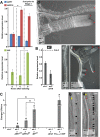Bimodular auxin response controls organogenesis in Arabidopsis
- PMID: 20133796
- PMCID: PMC2823897
- DOI: 10.1073/pnas.0915001107
Bimodular auxin response controls organogenesis in Arabidopsis
Abstract
Like animals, the mature plant body develops via successive sets of instructions that determine cell fate, patterning, and organogenesis. In the coordination of various developmental programs, several plant hormones play decisive roles, among which auxin is the best-documented hormonal signal. Despite the broad range of processes influenced by auxin, how such a single signaling molecule can be translated into a multitude of distinct responses remains unclear. In Arabidopsis thaliana, lateral root development is a classic example of a developmental process that is controlled by auxin at multiple stages. Therefore, we used lateral root formation as a model system to gain insight into the multifunctionality of auxin. We were able to demonstrate the complementary and sequential action of two discrete auxin response modules, the previously described Solitary Root/indole-3-Acetic Acid (IAA)14-Auxin Response Factor (ARF)7-ARF19-dependent lateral root initiation module and the successive Bodenlos/IAA12-Monopteros/ARF5-dependent module, both of which are required for proper organogenesis. The genetic framework in which two successive auxin response modules control early steps of a developmental process adds an extra dimension to the complexity of auxin's action.
Conflict of interest statement
The authors declare no conflict of interest.
Figures




Similar articles
-
Multiple AUX/IAA-ARF modules regulate lateral root formation: the role of Arabidopsis SHY2/IAA3-mediated auxin signalling.Philos Trans R Soc Lond B Biol Sci. 2012 Jun 5;367(1595):1461-8. doi: 10.1098/rstb.2011.0232. Philos Trans R Soc Lond B Biol Sci. 2012. PMID: 22527388 Free PMC article.
-
IAA8 involved in lateral root formation interacts with the TIR1 auxin receptor and ARF transcription factors in Arabidopsis.PLoS One. 2012;7(8):e43414. doi: 10.1371/journal.pone.0043414. Epub 2012 Aug 17. PLoS One. 2012. PMID: 22912871 Free PMC article.
-
The HAT2 gene, a member of the HD-Zip gene family, isolated as an auxin inducible gene by DNA microarray screening, affects auxin response in Arabidopsis.Plant J. 2002 Dec;32(6):1011-22. doi: 10.1046/j.1365-313x.2002.01488.x. Plant J. 2002. PMID: 12492842
-
Lateral Root Formation in Arabidopsis: A Well-Ordered LRexit.Trends Plant Sci. 2019 Sep;24(9):826-839. doi: 10.1016/j.tplants.2019.06.015. Epub 2019 Jul 27. Trends Plant Sci. 2019. PMID: 31362861 Review.
-
Root layers: complex regulation of developmental patterning.Curr Opin Genet Dev. 2008 Aug;18(4):354-61. doi: 10.1016/j.gde.2008.05.001. Epub 2008 Jul 9. Curr Opin Genet Dev. 2008. PMID: 18617392 Free PMC article. Review.
Cited by
-
Overexpression of wheat C2H2 zinc finger protein transcription factor TaZAT8-5B enhances drought tolerance and root growth in Arabidopsis thaliana.Planta. 2024 Oct 28;260(6):126. doi: 10.1007/s00425-024-04559-z. Planta. 2024. PMID: 39466433
-
Common Mechanisms of Developmental Reprogramming in Plants-Lessons From Regeneration, Symbiosis, and Parasitism.Front Plant Sci. 2020 Jul 16;11:1084. doi: 10.3389/fpls.2020.01084. eCollection 2020. Front Plant Sci. 2020. PMID: 32765565 Free PMC article. Review.
-
Transcriptional repression of BODENLOS by HD-ZIP transcription factor HB5 in Arabidopsis thaliana.J Exp Bot. 2013 Jul;64(10):3009-19. doi: 10.1093/jxb/ert137. Epub 2013 May 16. J Exp Bot. 2013. PMID: 23682118 Free PMC article.
-
CRISPR-TSKO: A Technique for Efficient Mutagenesis in Specific Cell Types, Tissues, or Organs in Arabidopsis.Plant Cell. 2019 Dec;31(12):2868-2887. doi: 10.1105/tpc.19.00454. Epub 2019 Sep 27. Plant Cell. 2019. PMID: 31562216 Free PMC article.
-
LBD13 positively regulates lateral root formation in Arabidopsis.Planta. 2019 Apr;249(4):1251-1258. doi: 10.1007/s00425-018-03087-x. Epub 2019 Jan 9. Planta. 2019. PMID: 30627888
References
-
- Vanneste S, Friml J. Auxin: A trigger for change in plant development. Cell. 2009;136:1005–1016. - PubMed
-
- De Smet I, et al. Receptor-like kinase ACR4 restricts formative cell divisions in the Arabidopsis root. Science. 2008;322:594–597. - PubMed
-
- Péret B, et al. Arabidopsis lateral root development: An emerging story. Trends Plant Sci. 2009;14:399–408. - PubMed
-
- Fukaki H, Tasaka M. Hormone interactions during lateral root formation. Plant Mol Biol. 2009;69:437–449. - PubMed
Publication types
MeSH terms
Substances
Grants and funding
- BB/D019613/1/BB_/Biotechnology and Biological Sciences Research Council/United Kingdom
- BB/G023972/1/BB_/Biotechnology and Biological Sciences Research Council/United Kingdom
- BB/H020314/1/BB_/Biotechnology and Biological Sciences Research Council/United Kingdom
- P 18840/FWF_/Austrian Science Fund FWF/Austria
LinkOut - more resources
Full Text Sources
Molecular Biology Databases

